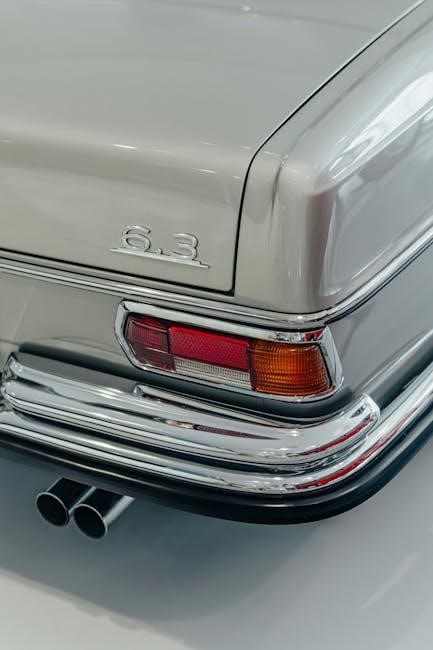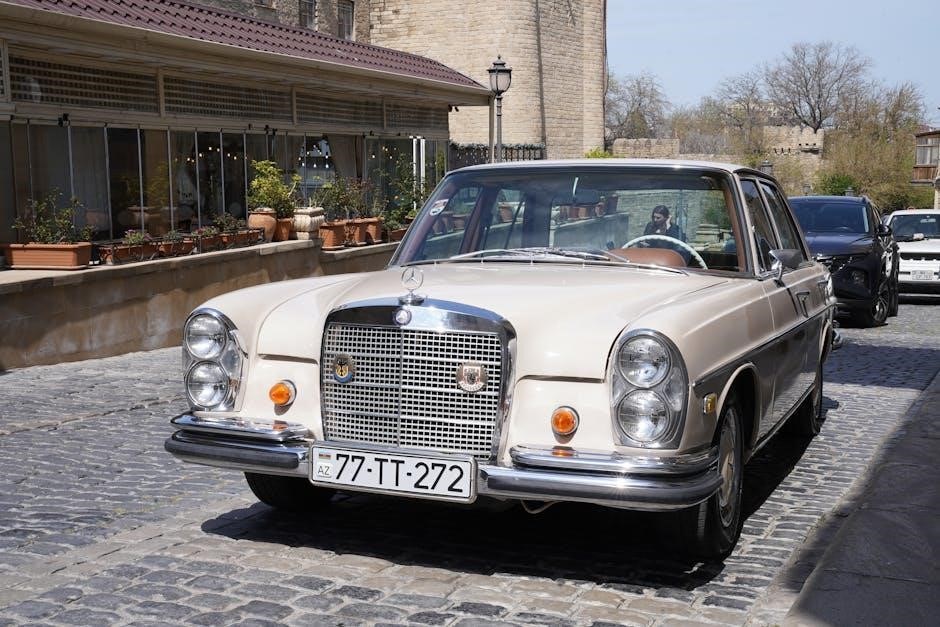Mercedes C300 Fuse Box Diagram PDF: A Comprehensive Guide
This PDF provides detailed fuse box locations and diagrams for the Mercedes-Benz C-Class, specifically models from 2008 to 2015, aiding in electrical system troubleshooting.
Understanding the electrical system of your Mercedes C300 relies heavily on knowing the location and function of its fuse boxes. These boxes house a network of fuses and relays, crucial components protecting the vehicle’s circuits from overloads and ensuring proper operation of various features. The Mercedes C300, spanning model years 2008-2015 (and the 2015 redesigned model), typically features at least two fuse box locations: one within the luggage compartment and another inside the instrument panel on the driver’s side.
A comprehensive fuse box diagram PDF is an invaluable resource for any C300 owner or mechanic. It details the precise location of each fuse, its amperage rating, and the corresponding electrical component it protects. Accessing this information allows for quick identification of blown fuses, efficient troubleshooting of electrical issues, and safe replacement of faulty components. Ignoring fuse box diagrams can lead to incorrect repairs and potential damage to the vehicle’s electrical system.
Understanding the Importance of Fuse Diagrams
Fuse diagrams are essential for maintaining the electrical integrity of your Mercedes C300. They act as a roadmap to the vehicle’s complex wiring, enabling accurate diagnosis and repair of electrical faults. Without a diagram, identifying the correct fuse for a specific component becomes a process of trial and error, potentially causing further damage or inconvenience.
A detailed PDF diagram provides a clear visual representation of fuse locations, amperage ratings, and the systems each fuse protects – from power windows and infotainment systems to critical engine components. This knowledge empowers owners to perform basic electrical repairs themselves, saving on costly mechanic fees. Furthermore, understanding fuse diagrams is crucial for safely adding aftermarket accessories, ensuring they are properly fused and don’t overload the vehicle’s electrical system. Ignoring these diagrams can lead to short circuits, fire hazards, and extensive electrical damage.
Mercedes C300 Model Years Covered (2008-2015)
This guide focuses on Mercedes-Benz C-Class models, encompassing the C180, C200, C220, C250, C300, C350, and C63 variants manufactured between 2008 and 2014 (W204 chassis). Additionally, a dedicated section covers the 2015 C300 model, acknowledging potential layout differences. While the core principles remain consistent, fuse box locations and specific fuse assignments can vary slightly between these years.
The provided PDF diagrams are tailored to these model years, offering accurate representations of fuse panel layouts. Owners of vehicles within this range will find detailed information regarding fuse positions, amperage ratings, and corresponding circuit protection. It’s important to note that minor variations may exist based on optional equipment or regional specifications. Therefore, cross-referencing with the vehicle’s owner’s manual is always recommended for absolute accuracy when using these diagrams for troubleshooting or repair.

Fuse Box Locations
Mercedes C300 models typically feature two fuse box locations: the primary box within the luggage compartment and a secondary box on the driver’s side.
Primary Fuse Box Location: Luggage Compartment
The primary fuse box in the Mercedes C300 is conveniently located within the luggage compartment, specifically on the right-hand side. Accessing this fuse box requires lifting the trunk floor upwards. You’ll then need to swing the cover upwards, following the direction indicated by the arrow – this reveals the fuse box itself.
This location houses a significant number of fuses responsible for controlling various vehicle functions, including lights, the infotainment system, and several comfort features. The diagram within the owner’s manual, or a dedicated PDF, will clearly illustrate the layout of the fuses within this compartment.
Carefully examine the diagram to pinpoint the specific fuse corresponding to the electrical component you are investigating. Remember to consult the amperage rating before replacing any blown fuses to ensure proper operation and prevent potential damage to the electrical system.
Secondary Fuse Box Location: Instrument Panel (Driver’s Side)
In addition to the primary fuse box in the luggage compartment, the Mercedes C300 also features a secondary fuse box strategically positioned on the driver’s side of the instrument panel. This location provides convenient access to fuses controlling essential systems readily used during operation.
Locating this fuse box is straightforward; it’s typically found behind a small access panel on the driver’s side, often near the steering wheel or the footwell area. Opening this panel reveals the secondary fuse box and its corresponding diagram. This diagram is crucial for identifying the correct fuse for any electrical issues.
Fuses within this box often manage components like the windshield wipers, interior lighting, and certain driver-assistance features. Always refer to the vehicle’s owner’s manual or a dedicated fuse box diagram PDF for precise fuse locations and functions before attempting any replacements.
Accessing the Luggage Compartment Fuse Box
The primary fuse box for the Mercedes C300 is conveniently located within the luggage compartment, specifically on the right-hand side; Accessing this fuse box requires lifting the trunk floor covering. This floor panel is designed to be easily lifted, revealing the fuse box beneath.
Once the floor is raised, you’ll notice a cover protecting the fuse box itself. This cover features an upward swing mechanism, indicated by an arrow, allowing for simple removal. Lifting this cover exposes the fuses and relays housed within. Before proceeding, it’s highly recommended to consult a Mercedes C300 fuse box diagram PDF to understand the layout and function of each fuse.
Ensure the vehicle is turned off before accessing or working with the fuses. Proper identification using the diagram is crucial to avoid damaging the electrical system. Remember to securely replace the cover after inspection or replacement.
Accessing the Instrument Panel Fuse Box
The secondary fuse box within the Mercedes C300 is strategically positioned on the driver’s side of the instrument panel. Locating this fuse box is relatively straightforward; it’s integrated into the dashboard’s design. Access typically involves removing a small panel or cover to reveal the fuses.
Unlike the luggage compartment box, the instrument panel fuse box may require a specific tool, or a firm but gentle pressure, to release the access panel. Consult your Mercedes C300 fuse box diagram PDF for precise instructions related to your model year, as panel release mechanisms can vary.
Always ensure the ignition is switched off before attempting to access or manipulate any fuses within this box. Proper identification using the diagram is vital to prevent accidental damage to the vehicle’s electrical components. Securely reattach the access panel after completing any necessary work.

Detailed Fuse Diagram Breakdown (2008-2014 W204)
This section details the W204 C-Class (2008-2014) fuse layout, pinpointing fuse positions, common functions, amperage, and relay locations for effective troubleshooting.
Fuse Box Diagram Overview ⏤ W204 C-Class
The W204 C-Class, spanning model years 2008 through 2014, utilizes a dual fuse box system for comprehensive electrical circuit protection. Understanding this layout is crucial for diagnosing and resolving electrical issues efficiently. The primary fuse box is conveniently located within the luggage compartment, typically on the right-hand side, concealed beneath the floor covering. Access requires lifting the trunk floor and swinging the cover upwards.
A secondary, smaller fuse box resides within the instrument panel, specifically on the driver’s side. This box handles circuits related to interior components and driver-centric systems. Detailed diagrams illustrate the precise arrangement of fuses and relays within each box. These diagrams are essential for identifying the correct fuse associated with a specific component.
Each fuse is labeled with a corresponding function, such as power windows, lights, or the audio system. The amperage rating, indicated on the fuse itself, is vital for replacement purposes. Utilizing the correct amperage fuse is paramount to prevent damage to the electrical system. Referencing the owner’s manual alongside the diagram ensures accurate identification and safe operation.
Identifying Fuse Positions within the Diagram
Locating specific fuses within the Mercedes C300’s W204 fuse diagrams requires a systematic approach. Diagrams typically present a grid-like layout, with each position clearly numbered or labeled. These labels correspond directly to the functions they protect – for example, “Radio,” “Wiper Motor,” or “Interior Lights.”
Carefully compare the diagram to the physical fuse box. The diagram’s orientation should match the actual layout. Often, diagrams will include a visual representation of the fuse box itself, aiding in orientation. Pay close attention to the fuse’s amperage rating, usually printed on the fuse itself and indicated on the diagram.
Relays are also depicted on the diagram, often distinguished by a different symbol or color coding. Identifying relay positions is crucial for troubleshooting more complex electrical issues. If a fuse appears intact but the corresponding component isn’t functioning, the relay may be the culprit. Always consult the owner’s manual for clarification and precise component locations.
Common Fuse Functions & Amperage (W204)
Several fuses frequently require attention in the Mercedes C300 (W204). The radio fuse, typically rated at 5-10 amps, protects the audio system. The cigarette lighter/power outlet fuse is commonly 15 amps. Interior lighting, including dome and map lights, often utilizes 5 amp fuses. The windshield wiper motor frequently uses a 20 amp fuse, while the rear window defroster may require a 25 amp fuse.
Power windows and door locks generally operate on 20-30 amp fuses. The fuel pump fuse is critical, usually rated at 20 amps. Always verify the correct amperage before replacement; using a higher amperage fuse can cause significant damage.
Consult the fuse diagram for precise amperage values for each function; Variations exist based on specific vehicle options and model year. Incorrect fuse replacement can lead to electrical malfunctions or even fire hazards, so accuracy is paramount.
Relay Locations and Functions (W204)
Relays, unlike fuses, control higher-current circuits and are crucial for components like the fuel pump, horn, and cooling fans. In the W204 C300, relays are primarily located within both the luggage compartment fuse box and the instrument panel fuse box. The fuel pump relay, vital for engine operation, is typically found in the luggage compartment.
The horn relay is often situated near the instrument panel fuse box. Cooling fan relays manage the engine’s temperature regulation and are also located in the luggage compartment. Identifying the correct relay requires referencing the detailed fuse diagram, as locations can vary.
Relay functions involve switching power to components on demand, reducing the load on the fuse system. Proper relay operation is essential for the functionality of numerous vehicle systems. Always consult the owner’s manual or a dedicated wiring diagram for precise relay locations and specifications.

Detailed Fuse Diagram Breakdown (2015 C300)
The 2015 C300 features a revised fuse layout compared to earlier models, necessitating a specific diagram for accurate identification of fuse locations and functions.
Fuse Box Diagram Overview ⏤ 2015 C300
The 2015 Mercedes-Benz C300 utilizes a more integrated fuse system compared to previous generations. The primary fuse box remains located within the luggage compartment, accessible by lifting the trunk floor and swinging the cover upwards. However, the diagram itself presents a reorganized layout, reflecting updated electrical components and features.
Key areas within the 2015 diagram include sections dedicated to the engine control unit, lighting systems (interior and exterior), infotainment, climate control, and safety features like airbags and ABS. Each fuse is clearly labeled with a corresponding amperage rating and a brief description of the circuit it protects.
Understanding the color-coding and symbol conventions used in the diagram is crucial for accurate identification. The diagram also indicates the location of relays, which control higher-current circuits. A detailed understanding of this overview is essential before attempting any electrical troubleshooting or fuse replacement.
Specific Fuse Functions for 2015 Models
The 2015 C300’s fuse system protects a range of advanced features. Fuses dedicated to the COMAND infotainment system, including navigation and audio, are critical for functionality. Several fuses govern the operation of the driver assistance package, encompassing features like lane keeping assist and adaptive cruise control.
Lighting systems receive dedicated fuses for headlights, taillights, and interior illumination. The electric seat adjustment, memory functions, and steering wheel controls each have specific fuse protection. Furthermore, the auxiliary power outlets and USB charging ports are individually fused for safety.
Modern additions like the automatic trunk closer and parking assist systems also rely on dedicated fuses. Identifying the correct fuse for a specific issue requires careful reference to the 2015 C300’s detailed fuse diagram, noting the amperage and circuit description for accurate diagnosis and repair.
Relay Identification in the 2015 C300
Relays in the 2015 C300 manage higher-current circuits, supplementing the fuse protection system. Key relays control the fuel pump, starter motor, and cooling fan operation – essential for engine functionality. The horn, windshield wipers, and power windows also utilize relays for efficient operation.
Identifying relays requires referencing the fuse box diagram, which details their specific locations and functions. Each relay is typically labeled with a number or code corresponding to the circuit it controls. Understanding these codes is crucial for diagnosing issues like a non-functioning starter or intermittent wipers.
Testing relays involves checking for voltage and continuity, often requiring a multimeter. Replacement should only be done with relays matching the original specifications. Proper relay function ensures reliable operation of critical vehicle systems, complementing the protective role of the fuses.

Troubleshooting with Fuse Diagrams

Fuse diagrams are vital for pinpointing electrical faults in your Mercedes C300, enabling quick identification of blown fuses and assisting in efficient system diagnostics.
Identifying a Blown Fuse
Locating a blown fuse is the first step in resolving many electrical issues within your Mercedes C300. Visually inspecting the fuse is often the easiest method; a blown fuse typically exhibits a broken filament within the clear plastic casing.
Compare the suspect fuse to a known good fuse from the same circuit – the broken filament will be immediately apparent. Alternatively, utilize a fuse tester, a small, inexpensive tool that quickly confirms fuse functionality.
Simply touch the tester’s probes to the fuse’s test points; a working fuse will complete the circuit, illuminating the tester’s light or emitting a tone. Remember to consult your Mercedes C300 fuse box diagram PDF to accurately identify the fuse responsible for the malfunctioning component before testing or replacement. Always ensure the ignition is off during inspection.
Fuse Replacement Procedures
Replacing a blown fuse is a straightforward process, but crucial for maintaining your Mercedes C300’s electrical systems. First, ensure the ignition is completely switched off. Locate the blown fuse using your Mercedes C300 fuse box diagram PDF and carefully remove it with the fuse puller tool – often found within the fuse box itself.
Never use your fingers or metal objects to remove fuses. Insert a new fuse of the exact same amperage rating. Using a higher amperage fuse can cause severe damage to the electrical system.
Push the new fuse firmly into place until it’s fully seated. After replacement, test the affected component to confirm functionality. If the new fuse blows immediately, a short circuit exists, requiring professional diagnosis and repair.
Tools Required for Fuse Replacement
Successfully replacing fuses in your Mercedes C300 requires minimal tools, ensuring a safe and efficient process. The most essential tool is a fuse puller, typically included within the fuse box itself – it prevents damage to the fuses and the box. A small, flat-head screwdriver can be used as an alternative, but exercise extreme caution to avoid short circuits.
Having a supply of replacement fuses with the correct amperage ratings is vital; consult your Mercedes C300 fuse box diagram PDF to confirm the correct specifications. A flashlight or work light is helpful for illuminating the fuse box, especially in dimly lit areas.
Gloves are recommended to protect your hands, and a multimeter can be useful for testing fuses if their condition is uncertain.
Safety Precautions When Working with Fuses
Prioritizing safety is paramount when working with your Mercedes C300’s electrical system. Always disconnect the negative terminal of the battery before commencing any fuse-related work; this prevents accidental short circuits and potential electrical shock. Never replace a fuse with one of a higher amperage rating – this can cause severe damage to the wiring and components.
Refer to your Mercedes C300 fuse box diagram PDF to identify the correct fuse for the specific circuit. Avoid touching the metal contacts of the fuses. If a fuse repeatedly blows, do not simply replace it; investigate the underlying cause of the short circuit or overload.
Work in a well-lit area and ensure the vehicle is parked on a level surface with the parking brake engaged. If unsure about any procedure, consult a qualified mechanic.

Resources and Further Information

Access Mercedes-Benz owner’s manuals, online databases, and video tutorials for detailed fuse box diagrams and troubleshooting electrical issues within your C300.
Mercedes-Benz Owner’s Manuals
Your Mercedes-Benz C300’s owner’s manual is the primary source for accurate and model-specific fuse box information. These manuals typically include detailed diagrams illustrating the location of both the primary (luggage compartment) and secondary (instrument panel) fuse boxes.
Within the manual, you’ll find precise fuse layouts, identifying each fuse’s function and amperage rating. This is crucial for selecting the correct replacement fuse. The manual also often provides guidance on accessing the fuse boxes, detailing any necessary removal procedures for trim panels or carpeting.
Furthermore, owner’s manuals frequently contain information about relay locations and their corresponding functions, complementing the fuse diagrams. If you’ve misplaced your physical manual, a digital version is usually available for download from the official Mercedes-Benz website, ensuring you always have access to this vital resource.
Online Fuse Box Diagram Databases
Numerous online databases specialize in automotive fuse diagrams, offering a convenient alternative or supplement to your owner’s manual. These resources often allow you to search by vehicle year, model, and trim level to pinpoint the correct diagram for your Mercedes C300.
Websites dedicated to automotive repair and maintenance frequently host user-submitted diagrams and troubleshooting guides. However, it’s crucial to verify the accuracy of information found on these platforms, cross-referencing with official Mercedes-Benz documentation whenever possible.
Some databases provide interactive diagrams, allowing you to click on individual fuse positions to reveal their function and amperage. Others offer downloadable PDF versions for offline access. Remember to exercise caution and prioritize reliable sources when utilizing online fuse box information to ensure correct fuse replacement and avoid potential electrical issues.
Video Tutorials for Fuse Box Locations
Visual learners often benefit from video tutorials demonstrating the precise locations of fuse boxes within the Mercedes C300. Platforms like YouTube host a wealth of content created by automotive enthusiasts and professional mechanics.
These videos typically provide a step-by-step guide, showing how to access both the luggage compartment and instrument panel fuse boxes. They often highlight the release mechanisms and cover removal processes, making it easier to locate the fuse panels.

Furthermore, some tutorials demonstrate how to interpret the fuse diagrams, explaining common fuse functions and amperage ratings; When selecting a video, prioritize channels with clear visuals, accurate information, and positive user feedback. Always verify the video’s applicability to your specific C300 model year to ensure the information is relevant and correct, supplementing your PDF guide.
Troubleshooting Electrical Issues with Fuse Diagrams
A Mercedes C300 fuse diagram PDF is invaluable when diagnosing electrical problems. If a component fails – lights, radio, windows – the fuse is the first place to check. The diagram pinpoints the fuse responsible for that specific system, saving time and frustration.
By referencing the diagram, you can quickly identify a blown fuse, often indicated by a broken filament. Replacing a blown fuse with one of the correct amperage is a straightforward fix. However, repeated fuse failures signal a deeper underlying issue, like a short circuit, requiring professional attention.

The PDF helps correlate symptoms with fuse locations, enabling a systematic approach to troubleshooting. It’s crucial to understand that fuses protect circuits; ignoring a blown fuse can lead to further damage. Use the diagram alongside owner’s manual information for comprehensive electrical system diagnosis.
